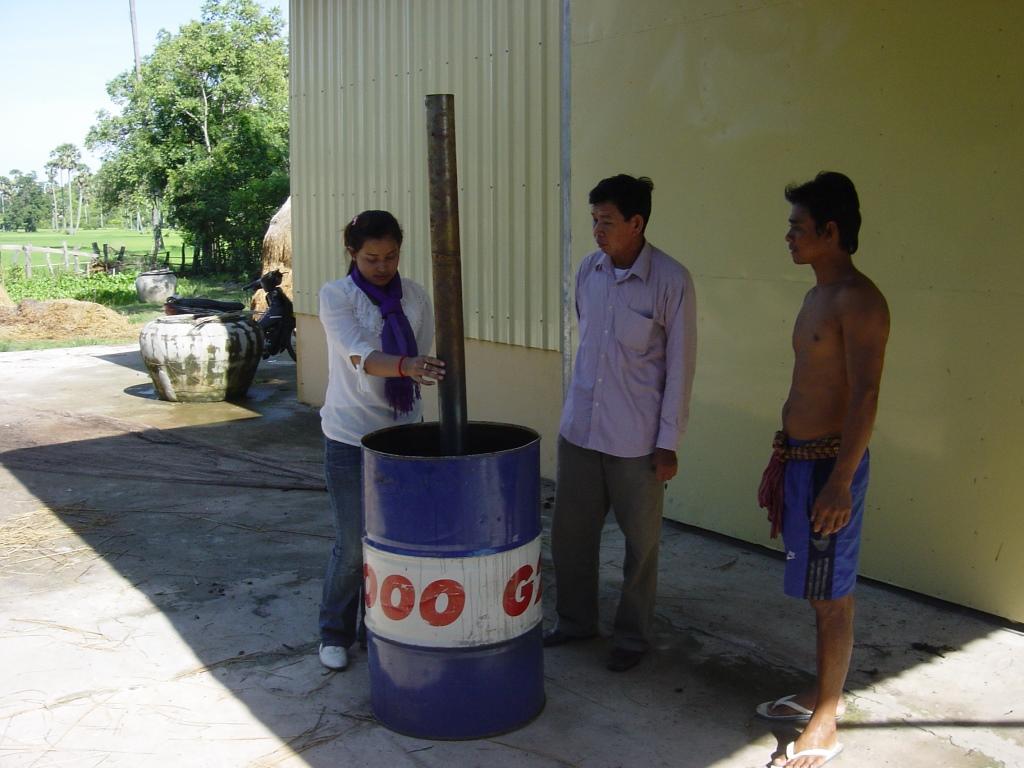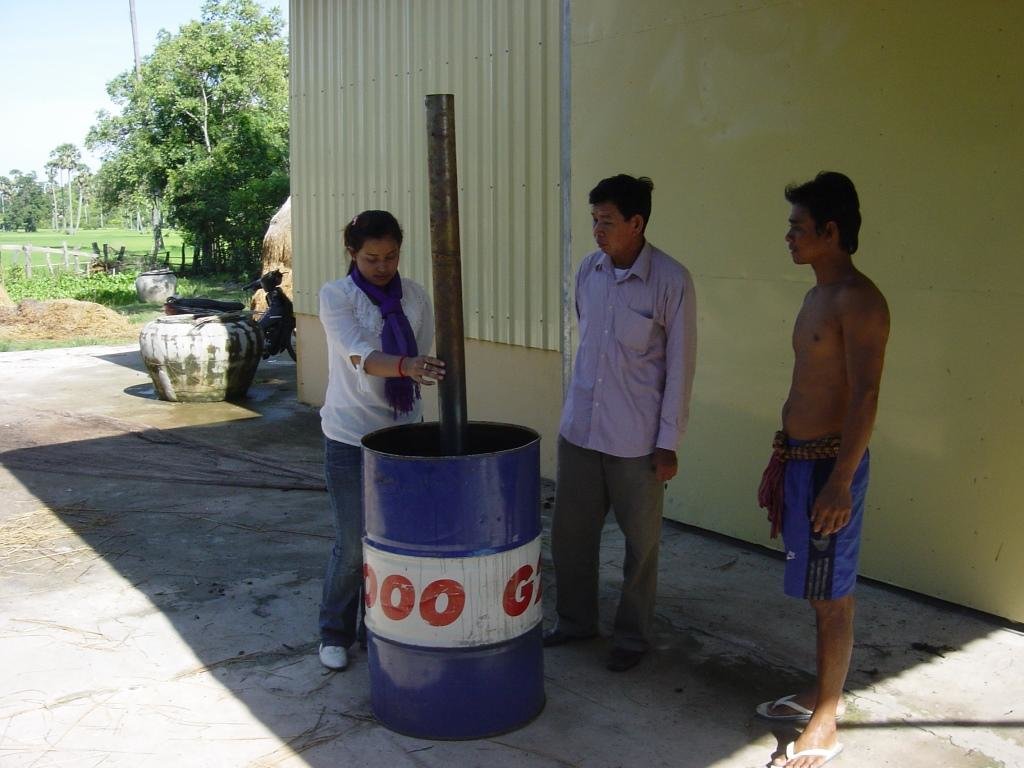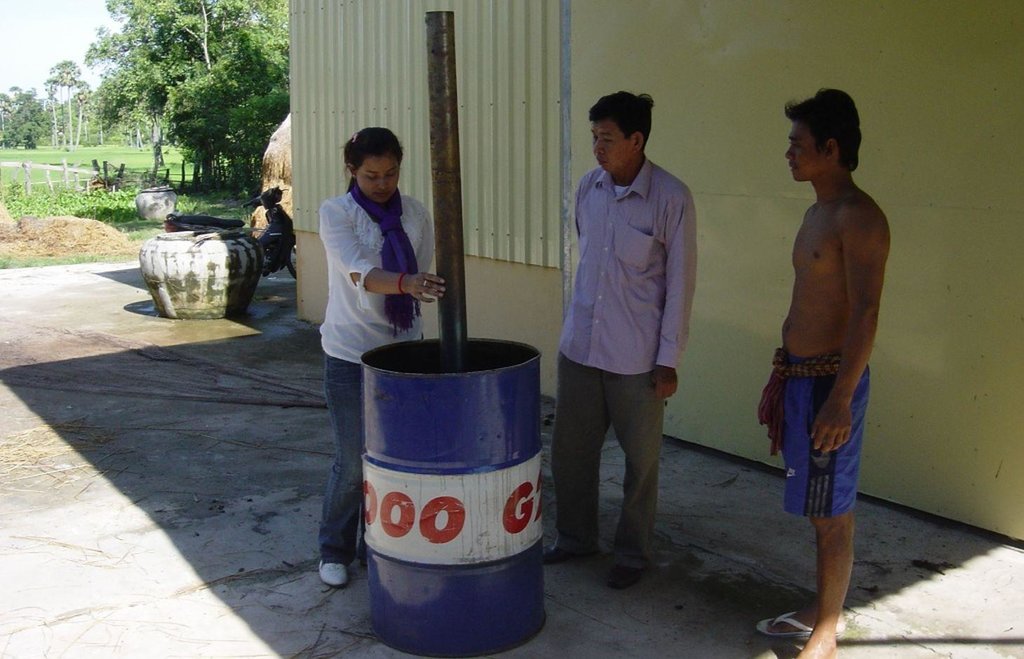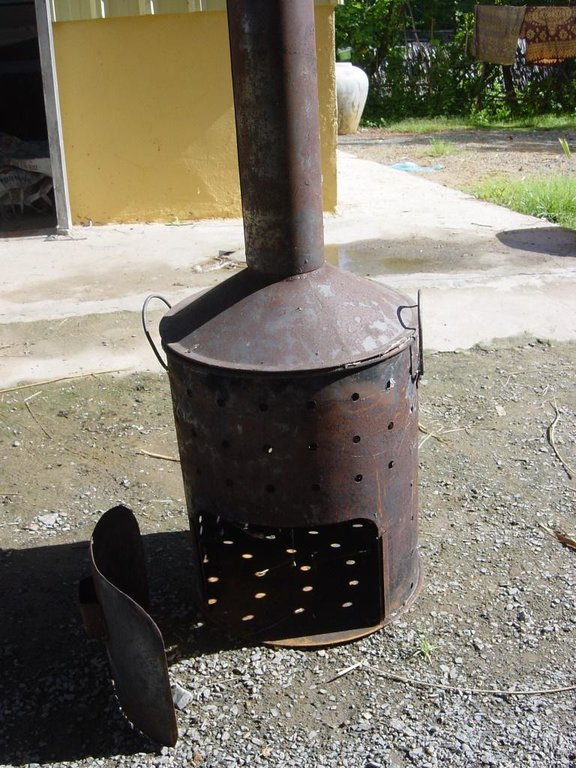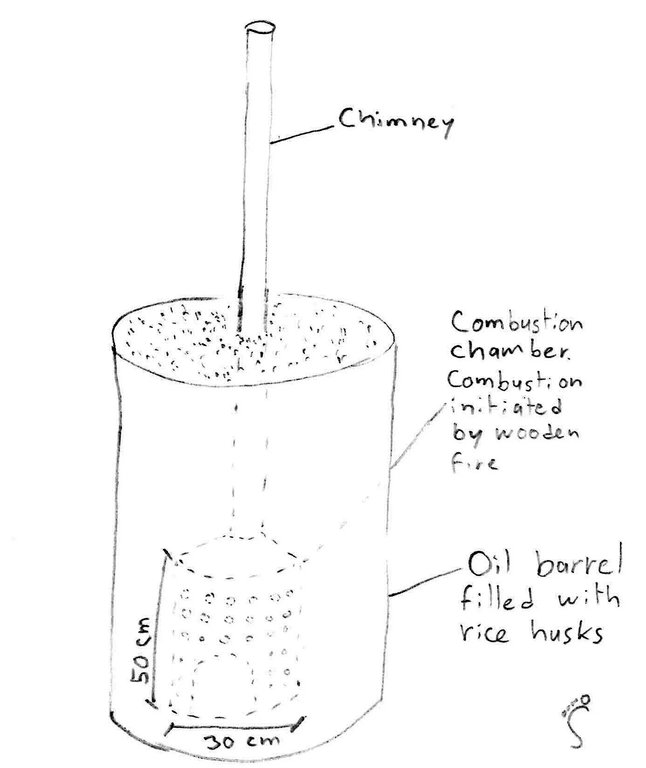Production and use of rice husk biochar in rice seed beds and vegetable production. [Cambodge]
- Création :
- Mise à jour :
- Compilateur : Stefan Graf
- Rédacteur : –
- Examinateurs : Alexandra Gavilano, Deborah Niggli
ការផលិត នឹងប្រើប្រាស់ជីធ្យូងអង្កាមលើថ្នាលសំណាបនឹងដំណំាបន្លែ (Khmer)
technologies_1229 - Cambodge
Voir les sections
Développer tout Réduire tout1. Informations générales
1.2 Coordonnées des personnes-ressources et des institutions impliquées dans l'évaluation et la documentation de la Technologie
Spécialiste GDT:
masson philippe
kleanghak@yahoo.com / sofdec@camintel.com
Professeur Emerité ENS AGRO
toulouse
Cambodge
Spécialiste GDT:
masson philippe
khonhel@gmail.com
Professeur Emerité ENS AGRO
toulouse
Cambodge
Spécialiste GDT:
masson philippe
Sreytouchbin@gmail.com
Professeur Emerité ENS AGRO
toulouse
Nom du ou des institutions qui ont facilité la documentation/ l'évaluation de la Technologie (si pertinent)
Society for Community Development in Cambodia (SOFDEC) - CambodgeNom du ou des institutions qui ont facilité la documentation/ l'évaluation de la Technologie (si pertinent)
Local Agricultural Research and Extension Centre (LAREC) - Cambodge1.3 Conditions relatives à l'utilisation par WOCAT des données documentées
Quand les données ont-elles été compilées (sur le terrain)?
14/08/2014
Le compilateur et la(les) personne(s) ressource(s) acceptent les conditions relatives à l'utilisation par WOCAT des données documentées:
Oui
1.4 Déclaration sur la durabilité de la Technologie décrite
Est-ce que la Technologie décrite ici pose problème par rapport à la dégradation des terres, de telle sorte qu'elle ne peut pas être déclarée comme étant une technologie de gestion durable des terres?
Non
2. Description de la Technologie de GDT
2.1 Courte description de la Technologie
Définition de la Technologie:
Rice husks as well as empty seeds are pyrolised and used as a soil amendment in the rice seed beds and the vegetable gardens.
2.2 Description détaillée de la Technologie
Description:
Biochar is the residue left after the pyrolysis of any organic matter and is used as a soil amendment. Pyrolysis occurs when the organic matter is heated in anaerobic conditions, which is usually done in specially designed kilns. Sometimes it is also made in a conventional fire, which is extinguished before the char turns to ash. Agricultural wastes like rice husks or unfilled grains are mainly used. Biochar can have many positive effects on the soil and plants:
-It buffers the pH, and has usually a high pH due to theash content.
-Due to its porous structure, it holds water and serves as refuge for microorganisms.
-It absorbs and adsorbs nutrients, both cations and anions. They are available for the plant roots.
-It can increase the resistance of plants to diseases.
Due to all these effects, the increased yields are higher than those that can be achieved only through the nutrients contained in the Biochar itself. Biochar is and was used in many parts of the world as soil amendment, with some benefits persisting for centuries. In Cambodia it was used during the Pol Pot regime to reduce the smell of the human faeces that were used on the fields due to a lack of other fertilizers. Today research in the Biochar domain is increasing, especially since the discovery of the man-made terra preta soils in South America.
Biochar is mainly used to increase the fertility, water holding capacity and carbon content of the soil. The fact that the benefits of Biochar addition to the soil remain for several years, unlike chemical fertilizers, makes it attractive to farmers. Other purposes, like the increased resistance of plants to diseases and buffering of nutrients are also of importance.
Biochar was introduced or reintroduced trough different NGOs, JICA (Japanese International Cooperation Agency) in this case study. Because of knowledge exchange between farmers, a rice husk char/ash mix, as residue from the pottery baking, was used already in 2011. In 2013 JICA borrowed a Biochar kiln to the local farmer self-help group with a training, so they could produce Biochar by themselves. The inner part of the kiln (cf. technical drawing) is filled with wood and lit. It is then put into an empty oil barrel, which is filled with rice husks. The heat pyrolyses the husks from the bottom to the top of the barrel, and the gases are burned in the inner part of the kiln and the chimney. Just before the upper part is pyrolysed, the husks are extinguished. There is a weight loss of about 50 to 60 % caused by this process. The Biochar is added to the fields after ploughing, and the fields are harrowed. In this case study, Biochar is used both in rice seed beds and in a vegetable patch. Concentrations of 0.5 kg/m2 are used in the rice seed bed, and 2.5 kg for the vegetables. Due to the little available quantities of husks, Biochar is not applied to the field yet. The use of Biochar is spreading quickly from farm to farm
The analysed area is flat (slope < 2%), with a tropical climate (dry season from November to May and wet season from June to October), and the soils are mostly sandy or loamy. The soil has a low fertility, contains little organic matter, and acidifies. The area has been deforested a long time ago, and the groundwater table is rather high (1-2 m during the dry season, on the surface during wet season).
Due to climate change, farmers notice more erratic rainfall, temperature rises and more recurrent droughts. Rice is the predominant crop grown in the area, since it serves as staple food (mix subsistence and commercial activities). Cattle are usually grazing on the fields after the harvest, without much control. Thus the cattle grazes too often and too much on the same spot, leading to degradation.
The increasing migration rate (the young generation leaves the villages to work in the cities, garment industry or abroad) results in a decrease of available labour force in the area which has detrimental effects on the agricultural activities. Furthermore, the civil war in the 1970s (Khmer Rouge) led to the loss of agricultural knowledge. Several NGOs are trying to re-establish the knowledge.
2.3 Photos de la Technologie
2.5 Pays/ région/ lieux où la Technologie a été appliquée et qui sont couverts par cette évaluation
Pays:
Cambodge
Région/ Etat/ Province:
Kampong Chhnang
Autres spécifications du lieu:
Kraing Leav
Map
×2.6 Date de mise en œuvre de la Technologie
Si l'année précise est inconnue, indiquez la date approximative: :
- il y a moins de 10 ans (récemment)
2.7 Introduction de la Technologie
Spécifiez comment la Technologie a été introduite: :
- par le biais de projets/ d'interventions extérieures
Commentaires (type de projet, etc.) :
It was introduced in 2010 by JICA, the Japanese International Cooperation Agency.
3. Classification de la Technologie de GDT
3.1 Principal(aux) objectif(s) de la Technologie
- améliorer la production
3.2 Type(s) actuel(s) d'utilisation des terres, là où la Technologie est appliquée

Terres cultivées
- Cultures annuelles
Principales cultures (vivrières et commerciales):
Livestock is grazing on crop residues
Commentaires:
Major land use problems (compiler’s opinion): Soil fertility decline, water availability
Major land use problems (land users’ perception): Water availability. Interestingly the farmer says that soil fertility is not a problem, as the farmers know about the use of compost. The compost application is the problem.
3.3 Informations complémentaires sur l'utilisation des terres
Approvisionnement en eau des terres sur lesquelles est appliquée la Technologie:
- mixte: pluvial-irrigué
Nombre de période de croissance par an: :
- 1
Précisez:
Longest growing period in days: 210, Longest growing period from month to month: June-December
3.4 Groupe de GDT auquel appartient la Technologie
- gestion intégrée de la fertilité des sols
3.5 Diffusion de la Technologie
Spécifiez la diffusion de la Technologie:
- répartie uniformément sur une zone
Si la Technologie est uniformément répartie sur une zone, indiquez la superficie couverte approximative:
- 0,1-1 km2
Commentaires:
Area unknown and rapidly spreading.
3.6 Mesures de GDT constituant la Technologie

pratiques agronomiques
- A2: Matière organique/ fertilité du sol
3.7 Principaux types de dégradation des terres traités par la Technologie

dégradation chimique des sols
- Cn: baisse de la fertilité des sols et réduction du niveau de matière organique (non causée par l’érosion)
- Ca: acidification

dégradation hydrique
- Ha: aridification
Commentaires:
Main causes of degradation: soil management (Ploughing and bare soil during dry season.), labour availability (Farmers go to work in the garment industry, in construction, or sell their labor elsewhere.)
Secondary causes of degradation: deforestation / removal of natural vegetation (incl. forest fires) (Deforestation happened many years ago.), overgrazing (Uncontrolled grazing during dry season.), change in temperature (More hot days according to UNDP and farmers.)
3.8 Prévention, réduction de la dégradation ou réhabilitation des terres dégradées
Spécifiez l'objectif de la Technologie au regard de la dégradation des terres:
- réduire la dégradation des terres
4. Spécifications techniques, activités, intrants et coûts de mise en œuvre
4.1 Dessin technique de la Technologie
4.2 Spécification/ explications techniques du dessin technique
Biochar kiln. In the inner part, the combustion chamber, a wooden fire is lit. The burning chamber is then placed in the oil barrel, which is filled with rice husks. The heat pyrolyses the husks, the gas burn in the chamber and chimney. When pyrolysis is almost completed, the char is extinguished.
Kampong Chhnang
Date: 2014
Technical knowledge required for field staff / advisors: high
Technical knowledge required for land users: moderate (When farmers only buy Biochar the required technical knowledge is low.)
Main technical functions: increase in organic matter, increase in nutrient availability (supply, recycling,…)
Secondary technical functions: improvement of surface structure (crusting, sealing), improvement of topsoil structure (compaction)
Manure / compost / residues
Material/ species: Rice husk Biochar (together with compost, which he already did before)
Quantity/ density: 0.5-2.5
Remarks: Entity: kg/m^2. Distributing on fields and harrowing.
4.3 Informations générales sur le calcul des intrants et des coûts
autre/ monnaie nationale (précisez):
Riels
Indiquer le taux de change du dollars en monnaie locale (si pertinent): 1 USD= :
4000,0
Indiquez le coût salarial moyen de la main d'œuvre par jour:
5.00
4.4 Activités de mise en place/ d'établissement
| Activité | Type de mesures | Calendrier | |
|---|---|---|---|
| 1. | biochar kiln |
4.5 Coûts et intrants nécessaires à la mise en place
| Spécifiez les intrants | Unité | Quantité | Coûts par unité | Coût total par intrant | % des coût supporté par les exploitants des terres | |
|---|---|---|---|---|---|---|
| Equipements | kiln | 1,0 | 50,0 | 50,0 | ||
| Coût total de mise en place de la Technologie | 50,0 | |||||
4.6 Activités d'entretien/ récurrentes
| Activité | Type de mesures | Calendrier/ fréquence | |
|---|---|---|---|
| 1. | Biochar making | Agronomique | Whenever there is time |
| 2. | Adding Biochar to the fields after the compost was plowed in, and harrowing. | Agronomique | Yearly, before planting. |
4.7 Coûts et intrants nécessaires aux activités d'entretien/ récurrentes (par an)
| Spécifiez les intrants | Unité | Quantité | Coûts par unité | Coût total par intrant | % des coût supporté par les exploitants des terres | |
|---|---|---|---|---|---|---|
| Main d'œuvre | labour | 1,0 | 20,0 | 20,0 | 100,0 | |
| Equipements | machine use | 1,0 | 0,25 | 0,25 | 100,0 | |
| Matériel végétal | rise husks | 1,0 | 4,0 | 4,0 | 100,0 | |
| Coût total d'entretien de la Technologie | 24,25 | |||||
Commentaires:
The costs are indicated per unit; a unit is one biochar kiln used on 1 a. The costs were calculated in 2014 for the vegetable beds, where the farmer uses around 2.5 kg/m2. He also uses Biochar on the rice seedling bed, with concentrations of around 0.5 kg/m2, 5 times less than in the vegetable patch. In the vegetable patch the farmer plants cucumber, pumpkin, onion, watermelon and leaf vegetables in the early wet season, before planting rice.
4.8 Facteurs les plus importants affectant les coûts
Décrivez les facteurs les plus importants affectant les coûts :
The factors affecting the cost the most are the biochar kiln, and the amount of added Biochar.
5. Environnement naturel et humain
5.1 Climat
Précipitations annuelles
- < 250 mm
- 251-500 mm
- 501-750 mm
- 751-1000 mm
- 1001-1500 mm
- 1501-2000 mm
- 2001-3000 mm
- 3001-4000 mm
- > 4000 mm
Spécifications/ commentaires sur les précipitations:
1486.45 mm 2013 in Kampong Chhnang
Zone agro-climatique
- subhumide
Thermal climate class: tropics. 27° to 35°C
5.2 Topographie
Pentes moyennes:
- plat (0-2 %)
- faible (3-5%)
- modéré (6-10%)
- onduleux (11-15%)
- vallonné (16-30%)
- raide (31-60%)
- très raide (>60%)
Reliefs:
- plateaux/ plaines
- crêtes
- flancs/ pentes de montagne
- flancs/ pentes de colline
- piémonts/ glacis (bas de pente)
- fonds de vallée/bas-fonds
Zones altitudinales:
- 0-100 m
- 101-500 m
- 501-1000 m
- 1001-1500 m
- 1501-2000 m
- 2001-2500 m
- 2501-3000 m
- 3001-4000 m
- > 4000 m
5.3 Sols
Profondeur moyenne du sol:
- très superficiel (0-20 cm)
- superficiel (21-50 cm)
- modérément profond (51-80 cm)
- profond (81-120 cm)
- très profond (>120 cm)
Matière organique de la couche arable:
- moyen (1-3%)
- faible (<1%)
5.4 Disponibilité et qualité de l'eau
Profondeur estimée de l’eau dans le sol:
< 5 m
Qualité de l’eau (non traitée):
faiblement potable (traitement nécessaire)
5.5 Biodiversité
Diversité des espèces:
- faible
5.6 Caractéristiques des exploitants des terres appliquant la Technologie
Orientation du système de production:
- subsistance (auto-approvisionnement)
- mixte (de subsistance/ commercial)
Revenus hors exploitation:
- 10-50% de tous les revenus
Niveau relatif de richesse:
- pauvre
- moyen
Individus ou groupes:
- individu/ ménage
Genre:
- femmes
- hommes
Indiquez toute autre caractéristique pertinente des exploitants des terres:
Land users applying the Technology are mainly common / average land users
Population density: 10-50 persons/km2
Annual population growth: 0.5% - 1%
Off-farm income specification: handicraft, remittances and factory work
5.7 Superficie moyenne des terres détenues ou louées par les exploitants appliquant la Technologie
- < 0,5 ha
- 0,5-1 ha
- 1-2 ha
- 2-5 ha
- 5-15 ha
- 15-50 ha
- 50-100 ha
- 100-500 ha
- 500-1 000 ha
- 1 000-10 000 ha
- > 10 000 ha
Cette superficie est-elle considérée comme de petite, moyenne ou grande dimension (en se référant au contexte local)?
- moyenne dimension
5.8 Propriété foncière, droits d’utilisation des terres et de l'eau
Propriété foncière:
- communauté/ village
- individu, sans titre de propriété
Droits d’utilisation des terres:
- communautaire (organisé)
- individuel
Droits d’utilisation de l’eau:
- accès libre (non organisé)
Commentaires:
Land users have a title that is not recognized by the state.
5.9 Accès aux services et aux infrastructures
santé:
- pauvre
- modéré
- bonne
éducation:
- pauvre
- modéré
- bonne
assistance technique:
- pauvre
- modéré
- bonne
emploi (par ex. hors exploitation):
- pauvre
- modéré
- bonne
marchés:
- pauvre
- modéré
- bonne
énergie:
- pauvre
- modéré
- bonne
routes et transports:
- pauvre
- modéré
- bonne
eau potable et assainissement:
- pauvre
- modéré
- bonne
services financiers:
- pauvre
- modéré
- bonne
6. Impacts et conclusions
6.1 Impacts sur site que la Technologie a montrés
Impacts socio-économiques
Production
production agricole
Commentaires/ spécifiez:
According to the farmer, 50 to 70 % yield increase on his vegetable patches.
Revenus et coûts
dépenses pour les intrants agricoles
Commentaires/ spécifiez:
Rice husks become a demanded product instead of a waste. On the other hand, less pesticides are needed.
charge de travail
Commentaires/ spécifiez:
Biochar has to be made and added to the fields.
Impacts socioculturels
sécurité alimentaire/ autosuffisance
Commentaires/ spécifiez:
Increased production, healthier plants/less pests.
situation sanitaire
Commentaires/ spécifiez:
Less pesticides needed.
contribution to human well-being
Commentaires/ spécifiez:
Increased income, less expenses on pesticides.
Impacts écologiques
Sols
humidité du sol
Commentaires/ spécifiez:
Plants can stand a short dry spell better if grown with Biochar.
cycle/ recharge des éléments nutritifs
Commentaires/ spécifiez:
A waste, rice husks, is returned to the soil. Biochar also adsorbs and absorbs nutrients.
matière organique du sol/ au dessous du sol C
Commentaires/ spécifiez:
The carbon from Biochar has a long half-life period in the soil .
Biodiversité: végétale, animale
contrôle des animaux nuisibles/ maladies
Commentaires/ spécifiez:
Less pesticides needed.
6.3 Exposition et sensibilité de la Technologie aux changements progressifs et aux évènements extrêmes/catastrophes liés au climat (telles que perçues par les exploitants des terres)
Changements climatiques progressifs
Changements climatiques progressifs
| Saison | Type de changements/ extrêmes climatiques | Comment la Technologie fait-elle face à cela? | |
|---|---|---|---|
| températures annuelles | augmente | bien |
Extrêmes climatiques (catastrophes)
Catastrophes météorologiques
| Comment la Technologie fait-elle face à cela? | |
|---|---|
| pluie torrentielle locale | pas connu |
| tempête de vent locale | pas connu |
Catastrophes climatiques
| Comment la Technologie fait-elle face à cela? | |
|---|---|
| sécheresse | bien |
Catastrophes hydrologiques
| Comment la Technologie fait-elle face à cela? | |
|---|---|
| inondation générale (rivière) | pas bien |
Autres conséquences liées au climat
Autres conséquences liées au climat
| Comment la Technologie fait-elle face à cela? | |
|---|---|
| réduction de la période de croissance | bien |
6.4 Analyse coûts-bénéfices
Quels sont les bénéfices comparativement aux coûts de mise en place (du point de vue des exploitants des terres)?
Rentabilité à court terme:
légèrement positive
Rentabilité à long terme:
positive
Quels sont les bénéfices comparativement aux coûts d'entretien récurrents (du point de vue des exploitants des terres)?
Rentabilité à court terme:
positive
Commentaires:
The costs for the pyrolysis kiln were not borne by the land user. But as the farmer of this case study wants to build an own kiln as soon as the NGO needs it again, it is positive.
6.5 Adoption de la Technologie
Commentaires:
100% of land user families have adopted the Technology with external material support
100 land user families have adopted the Technology with external material support
Considering only the farmers applying the technology with this stove. Other farmers buy Biochar, or burn the rice husks and extinguish them. But those farmers are nearly impossible to quantify as it changes quickly. The support was the kiln, which is only a small part of the costs.
Considering only the farmers applying the technology with this stove. Other farmers buy Biochar, or burn the rice husks and extinguish them. But those farmers are nearly impossible to quantify as it changes quickly.
In another area of Cambodia where the Ministry of Agriculture, Forestry and Fisheries (MAFF) is doing Biochar research, there was such a strong adoption of Biochar use that there are no more control areas. In Kampong Chhnang, the use of Biochar starts to spread now.
6.7 Points forts/ avantages/ possibilités de la Technologie
| Points forts/ avantages/ possibilités du point de vue de l'exploitant des terres |
|---|
| Less insect damages where Biochar is applied. |
| Good growth of vegetables, with increased yields especially for onions. |
| The rice seedlings are stronger, and the roots break less while transplanting, and the plants recover quickly. |
| The plants survive a short dry spell better. |
| Points forts/ avantages/ possibilités du point de vue du compilateur ou d'une autre personne ressource clé |
|---|
| Soil amendment with long-term effect, as Biochar has a long half-life period. |
| Buffering and raising of the pH, especially in sandy soils. |
| Less washing out of nutrients. |
6.8 Faiblesses/ inconvénients/ risques de la Technologie et moyens de les surmonter
| Faiblesses/ inconvénients/ risques du point de vue de l’exploitant des terres | Comment peuvent-ils être surmontés? |
|---|---|
| Substrate to make Biochar (rice husks) is difficult to find in the area in big amounts, as only small rice mills are working there. |
Rice husks are wasted in other places. Networking with other villages. Use other (waste) sources of organic matter like leaves. |
| Increased workload for the Biochar production (compensated by the increased yields). | Use a bigger kiln to decrease the workload. |
| Faiblesses/ inconvénients/ risques du point de vue du compilateur ou d'une autre personne ressource clé | Comment peuvent-ils être surmontés? |
|---|---|
| The energy produced during the pyrolysis is wasted. | Use it to power engines or as heating source. This would only be viable on large-scale kilns. |
7. Références et liens
7.1 Méthodes/ sources d'information
- visites de terrain, enquêtes sur le terrain
- interviews/entretiens avec les exploitants des terres
7.2 Références des publications disponibles
Titre, auteur, année, ISBN:
Ithaka Journal
Disponible à partir d'où? Coût?
www.ithaka-institut.org
Titre, auteur, année, ISBN:
Biochar foundation
Disponible à partir d'où? Coût?
www.britishbiocharfoundation.org
Liens et modules
Développer tout Réduire toutLiens
Aucun lien
Modules
Aucun module trouvé


